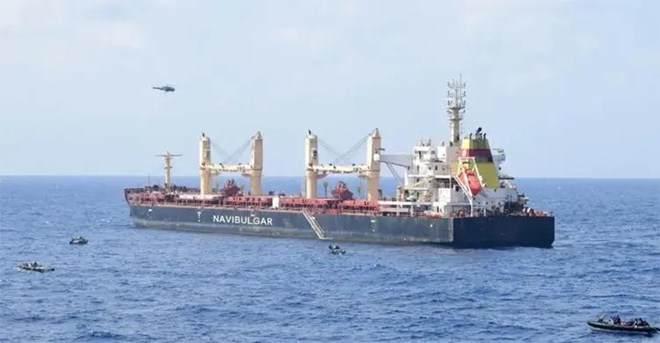
Thursday October 24, 2024

Boats maneuver around the pirated commercial ship MV Ruen during an Indian military operation on Saturday. Ministry of Defence/PIB via CNN
According to the Maritime Security Centre – Horn of Africa (MSCHOA), the PAG, consisting of 13 armed pirates, left Ceel Huur near Hobyo and is heading toward the Indian Ocean. “All vessels are advised to proceed with caution and report any suspicious activity,” the agency urged, reigniting fears of another wave of hijackings and attacks.
advertisements
The last significant pirate activity in the region occurred on June 7, 2024, when the Marshall Islands-flagged PACIFIC HONOR was approached by suspicious vessels. That incident ended without harm, but the message was clear: Somali pirates are biding their time. Martin Kelly, head of advisory at EOS Risk Group, explains the timing: “With the end of the monsoon season, weather conditions have improved. This gives pirates the opportunity to resume operations, and we’ve been warning clients of the increased risk.”The International Maritime Bureau (IMB) report from January to September 2024 reveals that while global piracy incidents have dropped to their lowest levels since 1994, Somali pirates remain active. Though the threat of Somali piracy had decreased from its notorious peak in the late 2000s, the tactics of modern-day pirates are becoming more sophisticated. Pirates no longer rely solely on small skiffs; instead, they commandeer dhows and fishing vessels, repurposing them as “mother ships.” These vessels enable pirates to strike targets as far as 800 nautical miles offshore, complicating international efforts to intercept them.
In a reminder of their capabilities, Somali pirates have made headlines with high-profile attacks in the past year. In December 2023, the MV Ruen was hijacked and held for three months before Indian naval forces freed the crew. In March 2024, the MV Abdullah was seized by pirates and only released after a ransom was paid.
Somali piracy does not exist in isolation. It is part of a broader regional crisis that includes Houthi rebel attacks on vessels in the Red Sea and Gulf of Aden. These attacks have forced shipping companies to reroute around the Cape of Good Hope, adding thousands of nautical miles to their journeys and increasing costs. Fewer ships are available for anti-piracy operations in the Indian Ocean, allowing pirates to operate with fewer restrictions. “The regional landscape has shifted, and with it, pirates have more opportunities,” Kelly noted while praising the Indian Navy for its role in recent rescues.
Global piracy incidents may be declining, with the International Maritime Bureau (IMB) reporting 79 incidents between January and September 2024—the lowest since 1994—but Somali waters remain a hotspot. Of the incidents reported, 111 crew members were taken hostage, 11 were kidnapped, and violence against crew members is on the rise. The IMB cautions that pirates’ ability to operate far from the Somali coastline makes them a persistent threat.
The global cost of piracy is staggering. In 2020 alone, piracy was estimated to cost the world economy $37 billion annually.